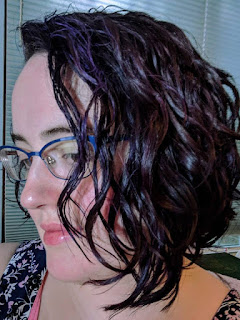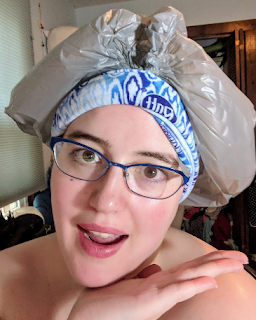Of all the Jessicurl products, I’ve heard about the Spiralicious Styling Gel the most by far. What really made me want to try it, however, is the fact that polyquaternium-69 is the second ingredient. PQ-69 is an absolute powerhouse when it comes to preventing frizz in humid climates as well as providing hold (click here for the Naturally Curly article on this awesome ingredient). It’s also the second ingredient in the gel I had been using previously, the Got2b Ultra Glued Invincible Styling Gel but, unfortunately, that product also has denatured alcohol as the sixth ingredient. I follow the CG method although I break the rules sometimes. Because my hair tends to be well-hydrated, drying alcohols aren’t necessarily a deal breaker for me as long as they aren’t one of the top ingredients and my hair seems to respond well to them. However, I still do my best to avoid drying alcohols and will favor a product without them (even if it’s more expensive) if it works just as well.
Speaking of PQ-89 and drying alcohols, let’s take a look at the full ingredients list for the Spiralicious Styling Gel. While I purchased this gel in the Citrus Lavender scent, this is the ingredient list for the unscented version so we can just look at the ingredients that are playing a non-fragrance role for the hair or product.
- Water
- Polyquaternium-69 (humidity resistance and hold)
- Hydroethylcellulose (a gelling and thickening agent)
- Jojoba Seed Oil (emollient)
- C12-15 Alkyl Benzoate (emollient and thickener)
- Panthenol (AKA Vitamin B-5; humectant and conditioner)
- Polyquaternium-11 (conditions and adds slip, body, and shine; can build up)
- Diazolidinyl Urea (preservative)
- Iodopropynyl Butlycarbamate (preservative)
- Alcohol [Ethanol] (a component of PQ-69)
There are a few controversial ingredients on this list, most notably the ethanol. Jessicurl notes on their website that this gel contains around 0.7% ethanol, which is too low to cause dryness. You can’t have PQ-89 without a little bit of ethanol so this truly doesn’t worry me. Some may also be concerned about the preservatives on the list, diazolidinyl urea and iodopropynyl butylcarbamate. The former is a formaldehyde-releasing preservative, which is a term that will always spook people. According to the CIR (Cosmetic Ingredient Review) Expert Panel, as long as this ingredient makes up 0.2% or less of a cosmetic product (as it almost certainly is here), it is safe. Iodopropynyl butylcarbamate is only of concern because it can be an irritant. As this isn’t an aerosol product or something you’d rub into the scalp, I’m not personally concerned about it, but if you have a bad reaction to this product, you may be sensitive to this ingredient.
The real star ingredients, in my eyes, are polyquaternium-69, jojoba oil, panthenol, and polyquaternium-11. As I mentioned above, PQ-69 provides hold and humidity resistance but it’s structure also makes it easier to wash out of hair than some other polyquats, which is great news if you no-poo or low-poo. Jojoba oil is a non-penetrating oil that seals moisture into the hair shaft which makes it a welcome addition to a product you’re likely applying last in your routine. Panthenol attracts water and softens hair but it is not a sugar-alcohol humectant like glycerin or sorbitol, which means you aren’t going to run into issues of it frizzing the hair in high humidity or drying it out in low humidity. PQ-11 is another great polyquat that forms a film on the hair, thickening individual strands as well as adding slip and shine. If your hair is prone to build-up and if you water wash or no-poo only (meaning you don’t cleanse using any surfactants, including non-sulfate surfactants such as cocomidopropyl betaine or decyl glucoside) you may want to keep an eye out for build-up, since PQ-11 won’t simply rinse out of the hair with water.
The Jessicurl Spiralicious Styling Gel doesn’t look like your typical hard hold gel, which I generally think of as being clear. Instead it’s white and a little runny. The hold is pretty strong although, unsurprisingly, not as strong as the Got2b Ultra Glued’s crazy hold. This makes sense because the Spiralicious has PQ-69 as its only hold ingredient whereas the Ultra Glued also has PVP and acrylates/steareth-20 methacrylate crosspolymer to bolster the hold. Unfortunately, those products are also prone to build-up which can be problematic for my low porosity hair.
 |
| Spiralicious Only |
For my next use, I used more than a quarter sized amount and got much more satisfactory results in the frizz department but it was still less hold than I wanted. Both times, the gel formed a slight cast that was easily scrunched out and left my hair soft and shiny, which I really enjoyed. My type 2 waves need more hold but I imagine that the Spiralicious on it’s own would be fantastic for those with type 3 curls. I found my hair’s personal sweet spot when I mixed the same, more-generous portion of the Spiralicious with a pea sized amount of the Ultra Glued. I cocktailed the two by mixing them in my hands and then scrunching the mixture into my hair. This gave me some more hold (and more crunch, which I like in a gel) but still left my waves touchable and with a healthy looking sheen.
 |
| Spiralicious and Ultra Glued |
Curl enhancement and definition are always my top priorities in a styling product. The Spiralicious gel isn’t curl enhancing but that isn’t really the job of hard hold gel, at least not in my routine. What it does extremely well, however, is give great definition. It seems to help my hair clump PERFECTLY: not so big that I’ve lost all my volume, and not so small that my waves look stringy. I just end up with these abundant, plump and juicy waves and curls and that is, ultimately, my favorite thing about this product.
I get nice second day hair with my Spiralicious/Ultra Glued cocktail and even decent third day hair, which used to just not be a thing for me. I still lose some curl on days two and three which is essentially unavoidable. However, I’m able to refresh pretty easily and get some more curl back if I feel like it. Perhaps most importantly, the frizz-fighting/humidity resistance effect seems to last which makes refreshing easier.
Personally I don’t mind that I have to use the Spiralicious with a second gel and I honestly feel like the combination of the two is greater than the sum of its parts. I understand, however, that some people want a styler to work on its own. If you’re one of them and you need that crazy, ultra-hold, this may not be the product for you. However, I still feel like it meets the qualifications for a hard hold gel, it just isn’t the hardest on the market.
I also want to mention that the citrus lavender scent is completely amazing. This is quite possibly my favorite scent for a hair product EVER. I don’t notice it lingering strongly in the hair but I also use a lot of other products and the scents could be competing. The citrus lavender scent comes from essential oils (lavender, sweet orange, and grapefruit) which can be a good or a bad thing, depending on your preference. If you have an allergy to any of those three plants, this scent is not the way to go. Jessicurl also offers two other options: unscented and a scent achieved through artificial fragrance, called “Island Fantasy.” Believe it or not, artificial fragrances are less likely to cause allergic reactions because they’ve been specifically formulated with that goal in mind. Regardless, between the three choices there should a good option for everyone. All three scent options are available for every product in their line, too, not just the Spiralicious gel.
I will definitely be purchasing a full size of the Jessicurl Spiralicious Styling Gel when my 2 oz bottle runs out and I already consider it a holy grail. I recommend this for anyone who likes medium to strong hold without excessive crunch or in combination with a stronger hold gel like the Got2b Ultra Glued for those of us who are all about that crazy hold, super-crunch life.








